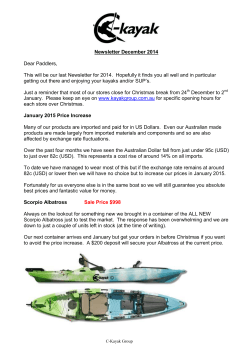
Manuals - Academy Sports + Outdoors
OWNER’S MANUAL Hydra and Aries SUP Boards Style #’s FSNOMD0001, FSNOMD0002 Please keep this instruction manual for future reference Customer Service: (888) 922-2336, 8:00am to 5:00pm, Central Standard Time, Monday thru Friday Read this manual before using this product. Failure to do so can result in serious injury or “death” IMPORTANT INFORMATION TO CONSERVE Keep your Owner’s Manual for future reference. In order to provide you with efficient and accurate service, please have the following information available: Model ______________________________________________ Serial Number ______________________________________________ (The serial number is located on the rear of the hull beside the handle. The number is 9 digits long) Date of Purchase ______________________________________________ Place of Purchase ______________________________________________ No-Limits Hydra Stand Up Board Model# FSNOMD0001 Specifications Length Width Depth Weight Capacity No-Limits Aries Stand Up Board Model# FSNOMD0002 9’6” 31.5” 7.9” 44lbs. 331lbs. 292cm 80cm 20cm 20kg 150kg Specifications MATERIAL Length Width Depth Weight Capacity 12’ 33” 7.9” 55lbs. 331lbs. 365cm 83cm 20cm 25kg 150kg Your paddleboard is manufactured from Linear Low Density Polyethylene (LLDPE). Our specially formulated .LLDPE has an ultra-violet inhibitor blended throughout the material to reduce color fade and maintain its strength. Your paddleboard is also equipped with foam for flotation. TRANSPORATION Handles located at both ends of the SUP enable it to be easily carried by hand. By hand: Two people can carry the board by using handles located at the front and rear. One person can use the center handle to transport the board, and, if necessary, use a device to aid in the transport. By Vehicle: Remove all accessories before transporting your SUP to avoid losing or damaging them Before starting your vehicle, ensure that the SUP is properly fastened using a transportation device on the roof of the vehicle or on a trailer. It is recommended that you stop shortly after starting your trip to double check that all connections are secure and the SUP will not move during transport. PRE-LAUNCH CHECKLIST 1. Always wear a proper personal flotation device (PFD). 2. Always have an emergency safety kit on hand that is required by applicable law (whistle, etc.) 3. Make sure the drain plug is securely in place and the compartment lid is closed (if applicable). 4. Make sure the length of your paddle is adjusted according to your size (see details described in “Basic SUP principles”). LAUNCHING PROCEDURE Do not stand up on the board if there are objects nearby that present a falling hazard (dock, rocks, etc.). Remain on your knees and use the paddle to move further away before standing up. You can return to a kneeling position at any time if a hazardous situation presents itself. Keep your paddle in hand at all times. Start by kneeling in the center and pressing your hands on both sides of the board for added stability. Stand up one foot at a time (use the paddle for balance). When you feel comfortable, start padding forward. Mooring/Docking If you want to moor your SUP to a dock, make sure that: It is away from rocks or sharp objects. The water is deep enough to avoid damaging the hull. BASIC SUP PRINCIPLES Learn and practice basic skills on a calm lake. Start slowly in open areas with few people around. Take your SUP Board through rough water only when you are confident about your abilities. For maximum comfort, make sure you have a paddle with a length that fits your size. In general, you should add 8 to 9 inches to your height to determine the length of the paddle. For example if you are 5 feet 10 inches (70 inches) tall, your paddle should be 78-80 inches long. You should stand in the center of the board when you paddle. In calm water, your feet should be positioned a shoulder width apart and pointing forward. In waves or rougher water, you should move a foot towards the back of the board and assume a surfing position. Practice moving your feet on the board and changing position to improve your balance. The best way to make a quick turn with your board is to move your weight back. Be careful in windy conditions, your body is completely exposed when standing upon and strong winds greatly affect your movements and push you off course. Adopting a kneeling or sitting position when faced with such condition can prevent wind from affecting your course. SAFETY PRECAUTIONS Read the following information outlined below before using your paddleboard. Failure to follow the warning precautions below may lead to serious injury including the possibility of death. Paddle sports can be dangerous and physically demanding. Every person using an SUP sold by No Limits is personally responsible for determining if their abilities match the encountered conditions and should use their best judgment as to the time and place to use the SUP. All individuals who use a Pelican SUP assume all risks and accept all responsibility for any damage or injury, including death, which may result from using or handling a SUP. It is strongly recommended you take a course offered by an experienced instructor on proper paddling techniques, boating security and first aid before practicing the sport. 1. Weight capacity Review the passenger and weight capacity limitations. Never exceed this capacity. Proper distribution of weight is necessary to ensure proper balance and performance. 2. Weather conditions and water levels Check weather conditions and water levels before heading out. Never go out in conditions that could affect your ability to steer the board, including severe wind, heavy rain, thunderstorms, flooding, choppy water or strong currents. If you are already on the water head to shore. 3. Personal flotation device (PFD) Always wear your U.S. Coast Guard and/or government approved life jacket (PFD). Before you start to paddle, read the manufacture’s documentation about the lifejacket and familiarize yourself with how to properly wear it. 4. Alcohol and drugs Never use or consume alcohol, drugs or and other mind altering substance that may affect your coordination, judgment or ability to safely and securely operate your SUP. 5. Sound signaling device Always have a sound-signaling devise with you. The Coast Guard (or other government bodies) require that boaters are equipped to alert other vessels to their presence. If possible, attach a devise to your lifejacket. 6. Ability Do not exceed your ability. Consult your physician before beginning your SUP training. Realistically assess your physical stamina to determine how far and how long you can paddle or swim. 7. Traction on the SUP The hull material is extremely slippery when wet. Stay within the traction zone to avoid slipping. We recommend you wear non-slip shoes for more traction. This will also protect your feet when launching and if you walk on rocks. 8. Hypothermia Dress appropriately for weather conditions, and if necessary, wear a wetsuit. Boating accidents in cold water are very dangerous. Hypothermia, the loss of body heat due to immersion in cold water, can be fatal. Survival time can be as little as 15 to 20 minutes in cold water. CARE AND MAINTAINANCE Your paddleboard is designed to require minimal maintenance, and a little timely care will ensure a lifetime of enjoyment. Whenever you wash your paddleboard, use mild soap and water. Rinse your paddleboard and hardware thoroughly after paddling in brackish or salt water. Occasional operational checkups will keep your paddleboard in tip top condition. Give your hull and deck a thorough review annually. Light nicks, scratches and scrapes are part of the paddling experiences, but deep scratches should be repaired. STORAGE 1. To protect your paddleboard, provide shelter from sun using a tarp suspended above the paddleboard. 2. To prevent excessive heat build-up, do not cover paddleboard with tarp laying directly on its surface. 3. Leave adequate air space to allow for air circulation. If possible, it is best to store your paddleboard inside for the winter. 4. Do not allow water to accumulate between the deck and hull and freeze. Freezing damages the flotation foam.
© Copyright 2025



















